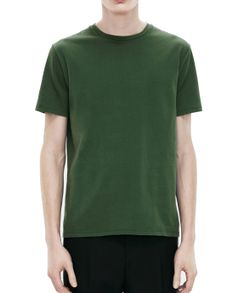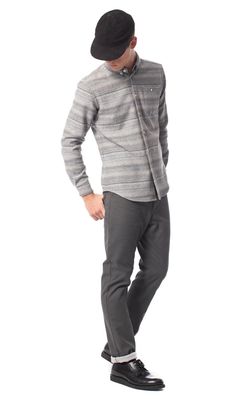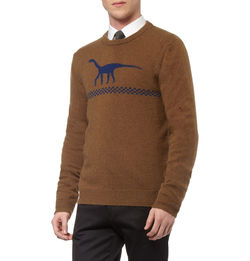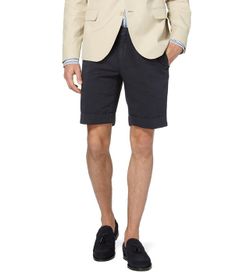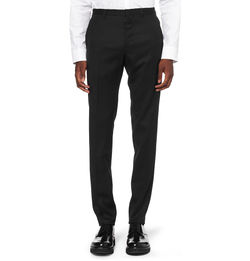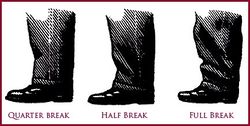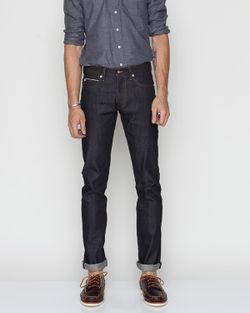Difference between revisions of "Men's Basics"
| (110 intermediate revisions by 60 users not shown) | |||
| Line 1: | Line 1: | ||
New to /fa/? Come here from MFA and need to start over? Girlfriend burn your clothes? We understand. | New to /fa/? Come here from MFA and need to start over? Girlfriend burn your clothes? We understand. | ||
| − | + | Below you will find a quick guide to wardrobe essentials. | |
| − | + | Also, please read the '''[[Introduction]]'''. | |
| − | + | ||
| − | + | ||
== Tops == | == Tops == | ||
| − | + | ===T-Shirts=== | |
| + | [[File:teeshirt.jpg|thumb|250px|Acne crew neck tee.]] | ||
| − | + | '''Color:''' | |
| + | White, navy, black, heather grey, slate, and dark green can be worn with almost anything without much thought and work with most skin tones. Pale versions of otherwise bold colors will also tend to be more versatile than their more richly colored counterparts--pale pink, pale yellow, pale blue (as opposed to electric blue), etc. Solid color tees should suit your skin and hair, not clash with or closely match your skin tone. And, in general, men with darker features will find it easier to wear bolder colors. | ||
| − | + | Men might find color selection to be one of the more difficult aspects of clothing selection, and much of the advice floating around online isn't very helpful. Your best bet is to experiment with different colors--eliciting the advice of a trusted friend if possible. Even if a color is considered extremely versatile, if you don't like the way it makes you look, don't wear it. | |
| − | |||
| + | '''Fit:''' | ||
| + | Try to find tees that aren't too loose or too tight. And while there is no "ideal fit" (some men like to wear over sized tees to emphasize their leanness), one of the fundamentals of dressing well is knowing how things ''should'' fit. One of the most important markers is the shoulder seam. It should line up with the "point" of your shoulder. | ||
| − | + | There are also multiple styles of necklines such as the scoop neck and the v neck, but the crew neck will be the most versatile. A crew neck is simply the ubiquitous rounded neckline that most tees have. V necks, however, are ideal undershirts as they remain hidden when worn underneath a partially unbuttoned shirt. | |
| − | |||
| − | + | '''Other Considerations''' | |
| − | * | + | *If you don't want the sleeves of a tee to flare out search for companies that make tees with tapered sleeves like Uniqlo, J Crew, or James Perse. |
| − | *A shirt with " | + | *Consider whether you prefer thicker or thinner material for your tees. |
| + | |||
| + | *Consider how you'd like your tees to hold up after multiple washes. A cheaper shirt might look nice at first, but careless washing may cause it to quickly pill (become nappy), warp, fade, or even come undone along the seams. This is especially true of tees with synthetic blends, which become nappy easily. In general, cold water and line drying or drying on a no-heat setting will help maintain the shirt's original look. | ||
| + | |||
| + | *Other styles of tees: thermal tees, raglan (aka baseball tees), henleys, patterned tees (color blocked, striped, speckled etc.), and graphic tees are all great additions to a wardrobe. | ||
| + | |||
| + | ====Recommended Brands==== | ||
| + | |||
| + | ''Under $10'' | ||
| + | |||
| + | *Gildan, H&M, Mossimo Supply Co. (aka Target brand, "athletic fit"), Uniqlo | ||
| + | |||
| + | ''$15-45'' | ||
| + | *Everlane, GAP, Urban Outfitters, American Apparel, Alternative Apparel, J Crew, COS | ||
| + | |||
| + | ''$45 & Up'' | ||
| + | |||
| + | *James Perse, Splendid Mills, Acne, Sunspel, Alexander Wang, Jil Sander, Our Legacy | ||
| + | |||
| + | |||
| + | ===Shirts=== | ||
| + | [[File:shirt2.jpg|thumb|250px|Patrik Ervell heavy button collar shirt.]] | ||
| + | Button-downs and button-ups are often simply referred to as "shirts" by clothiers. As with anything else, having the right fit is important. Nowadays, well tailored, slim fitting shirts are easy to find (look or ask for shirts denoted as "slim"), but consider taking your shirts to a tailor if you can't find that perfect fit off the rack, especially if it's for a minor alteration like having a sleeve shortened. | ||
| + | |||
| + | '''Color:''' | ||
| + | Solid colored oxfords (white and light blue are popular) and at least one white dress shirt (to be worn with a suit) is a good starting point. Plaids are also a fine option, including patterns like gingham, tattersall, and madras. | ||
| + | |||
| + | '''Fit:''' | ||
| + | A shirt's shoulder seam should fit on the "point" of your shoulder. This is the most important part of a proper fit, as it is the most difficult to alter. A shirt's waist should not puff out too much. This indicates that the shirt is cut too boxy (a "traditional" fit) or is too large. Look for ready tailored shirts denoted as "slim" or "tailored." | ||
| + | |||
| + | '''Dress Shirts and Sport Shirts''' | ||
| + | |||
| + | Note the difference between dress shirts and sport shirts. Dress shirts feature a stiff collar and/or collar stays, a spread collar (to accommodate a tie), will generally be made of finer fabrics, will not have more than one pocket, and may size by sleeve and neck measurements. Sport shirts are often made out of coarser fabrics like oxford cloth, may have multiple pockets, feature less conservative patterns, a button down collar, and may use small, medium, and large sizing. | ||
| + | |||
| + | Dress shirts should generally not be worn causally and should be tucked in. Sport shirts can be worn causally, but also with a suit and tie in less formal occasions. If worn untucked, a shirt should extend mid way down the fly, but not farther than the bottom of the fly. | ||
| + | |||
| + | |||
| + | '''Other notes''' | ||
| + | *Generally, avoid black dress shirts unless you're top gun at the local Applebees. | ||
| + | |||
| + | *Avoid over designed shirts: embellishments like epaulets and buttoned tabs down the middle of the sleeve look like shit. | ||
| + | |||
| + | *Avoid neon and bright pastel shirts. Their flashiness may catch your eye when shopping, but you will find yourself feeling very tacky when you actually put them to use. | ||
| + | |||
| + | *Shirts do not have to be washed after every wear, especially when worn with an undershirt. Wash it when it becomes dirty or smells. If you care about your clothing, take care in how you wash it. | ||
| + | |||
| + | *Leave the top button undone unless you're wearing a tie. | ||
| + | |||
| + | ====Recommended brands==== | ||
| + | |||
| + | ''Under $50'' | ||
| + | |||
| + | *Asos, Zara, H&M, Uniqlo, Gap | ||
| + | |||
| + | ''Under $100'' | ||
| + | *Polo Ralph Lauren (look for "custom" and "slim" fit shirts), Express, J Crew, Club Monaco, Bonobos, Brooks Brothers (look for slim styles) | ||
| + | |||
| + | ''Over $100'' | ||
| + | *Gant, J Press/York Street, Gitman Bros, Gitman Vintage, Patrik Ervell, Thom Browne, Brioni. | ||
| + | |||
| + | ===Sweaters, Knits, and Hoodies=== | ||
| + | [[File:sweater1.jpg|thumb|250px|Jil Sander camel and wool blend sweater.]] | ||
| + | Cotton sweaters, wool knits, cardigans, and hoodies allow for layering in casual and business casual environments. | ||
| + | |||
| + | '''Color:''' | ||
| + | Navy, black, grey and heather grey are common choices for cotton crews and hoodies; and navy, grey, camel, dark grey, and dark green for fine woolen sweaters. | ||
| + | |||
| + | '''Fit:''' | ||
| + | You should generally buy the same size sweater that you buy for shirts, despite the common misconception that there is a need to "size up" to accommodate for the shirt underneath. | ||
| + | |||
| + | Thick woolen sweaters are inherently more casual and should generally not be used for business environments. Fine woolen v neck sweaters offer room for ties and while these can be worn casually, however, especially deep v necks should not be worn without ties. | ||
| + | |||
| + | |||
| + | Feel free to purchase sweaters with different patterns and styles like stripes, color blocked sweaters, speckled Donegal sweaters, cable knit sweaters, fisherman sweaters, etc. | ||
| + | |||
| + | But, for the love of god, do not buy an argyle sweater. | ||
| + | |||
| + | ====Recommended Brands==== | ||
| + | |||
| + | '''Cotton Hoodies and Sweaters''' | ||
| + | |||
| + | ''Under $100'' | ||
| + | |||
| + | *Uniqlo, American Apparel, J Crew, American Giant, Archival | ||
| + | |||
| + | ''Over $100'' | ||
| + | *Norse Projects, Acne, A.P.C, Carhartt WIP, Reigning Champ, Loopwheeler, The Real McCoy, Left Field, Our Legacy, Wings + Horns, Sunspel, Alexander Wang | ||
| + | |||
| + | '''Wool Knits''' | ||
| + | |||
| + | ''Under $100'' | ||
| + | *Uniqlo, J Crew, Banana Republic | ||
| + | |||
| + | ''Over $100'' | ||
| + | *Folk, Jil Sander, A.P.C, Zanone, Zegna | ||
| + | |||
| + | ''Over $200'' | ||
| + | *Loro Piana, SNS Herning, Howlin by Morrison | ||
== Bottoms == | == Bottoms == | ||
| − | |||
| − | + | ===Shorts=== | |
| + | [[File:shorts.jpg|thumb|250px|Incotex linen and cotton blend shorts.]] | ||
| − | + | As a beginner, opt for solid colored shorts like gray, navy, and khaki. Flat front chino shorts should be your first selection (burn your cargo shorts). | |
| − | + | Look for shorts that end just above the knee cap or higher, whatever you're most comfortable with. For most men this will mean a 10" or shorter inseam. In general you'll want the opening of your shorts to be wide--wider than you'd want from your pants, both for the sake of air circulation and for looks. Skinny, thigh hugging shorts tend to be unflattering. | |
| + | Chambray and linen shorts are also widely available during the spring/summer season. Seersucker, a less popular choice, is notable for its breathability and wavy texture. The only varieties generally rejected on /fa/ are plaid shorts and denim shorts. | ||
| + | ====Recommended Brands==== | ||
| − | '' | + | ''Under $50'' |
| − | * | + | *H&M, Uniqlo, Gap |
| − | + | ''Over $50'' | |
| + | *Chubbies, J Crew, Club Monaco, Vineyard Vines, Gant, Incotex, AMI, Kenzo | ||
| + | ===Pants=== | ||
| + | [[File:trousers.jpg|thumb|250px|Jil Sander wool and cashmere blend trousers featuring a slight break.]] | ||
| + | [[File:breaktrousers.jpg|thumb|250px|An example of several breaks.]] | ||
| + | Slim flat front chinos in neutral and earth tones as well as navy or charcoal wool trousers work for casual and more formal outfits. (If you've never heard of the term "chino", you may have been calling them "khakis." Chino is the more correct term.) | ||
| + | Consider the color of your dress shoes (particularly if you don't have a variety) when selecting dress pants. Don't wear white pants. | ||
| + | |||
| + | '''A Note on Breaks:''' | ||
| + | The "break" of a pair of pants refers to how the fabric falls, folds, or "breaks" onto the shoe. A "full break" or too much break sees the fabric folding over heavily onto the shoe. This is generally not in style and can appear careless and sloppy. A slight break or no break, on the other hand, has been popular in recent years. The term "highwaters" refers to pants so short or rolled up that the entire ankle is visible, a style exemplified by Thom Browne. Your safest option will be a slight or medium break in formal settings. Worn casually, a rolled cuff on a pair of chinos or jeans can allow for airflow during warmer months. | ||
| − | + | ====Recommended brands==== | |
| − | + | ''Under $100'' | |
| − | * | + | *Uniqlo, Dockers Alpha Khaki, GAP, J Crew, Polo Ralph Lauren |
| − | + | ''Over $100'' | |
| − | * | + | *Epaulet, Slowear, Jil Sander |
| − | + | ===Jeans=== | |
| + | [[File:jeans1.jpg|thumb|250px|United Dry Stock Goods raw selvedge denim.]] | ||
| − | + | Dark "raw" jeans and a mid blue faded jean are the most versatile jeans you can have in your wardrobe. Many men also like a pair of black jeans. It depends on personal preference. | |
| + | Side Note: Outsourcing in the 90s made jeans cheaper, but didn't make them better (see our entry on [[Levi's]] for a case in point). We couldn't more strongly advise you--particularly if you wear jeans every day--spend more on your jeans than you might be used to spending. | ||
| − | + | '''Fit:''' | |
| + | Look for a fit that compliments your body. For most men, a slim tapered jean will work best (look for the term "slim") as it follows the natural shape of the leg. For larger men or men with large thighs, a straight cut ("straight" or "slim straight") might be a better option. Don't feel the need to stick to any one fit either. It's nice to have some variety. | ||
| − | + | Consider buying jeans that feel snug in the waist and around the groin as denim will stretch over time. | |
| − | *[[Boots]]: Boots are | + | '''Raw Denim:''' |
| + | Raw jeans come from the factory unwashed and can be identified by their uniform, dark indigo color and the stiffness of their fabric. The value of raw denim is that it allows natural fading to occur over time as indigo loosens around stress points. This stands in starch contrast (huehue) to pre-faded jeans which have artificial fading and distressing that often appears inauthentic, out of sync with the wearer's body, or simply bad. | ||
| + | |||
| + | Part of the aversion /fa/ has towards prefaded jeans, however, comes from the style's dominance in lower priced markets. "Cheap" and "prefaded" have become synonymous. This is--to an extent--an unfair generalization, and prefaded jeans at higher price points, using more sophisticated and considered processes, dyes, and construction are worth considering especially given how versatile a smartly faded blue jean can be. | ||
| + | |||
| + | '''Selvedge Jeans:''' Selvedge is a type of fabric that creates a clean edge or "self edge" visible on the outseam. A large percentage of higher end jeans are made with selvedge denim. All jeans used to be made with selvedge denim. You don't have to get selvedge or even raw jeans, but you should get something better than a pair of Levi's when you can afford it. | ||
| + | |||
| + | See '''[[Denim 101]]''' for a list of recommended brands and a guide to everything denim. | ||
| + | |||
| + | == Shoes == | ||
| + | |||
| + | *'''[[Sneakers]]''': Canvas sneakers are a hallmark of spring and summer outfits. Suede and leather sneakers, as well as some running sneakers, work with a variety of outfits and have the benefit of being comfortable and low profile. | ||
| + | |||
| + | *'''[[Boots]]''': Boots are a good option for colder months, but can be worn year round. A decent quality boot will have a certain luster and depth of color that cheaper boots won't and will be more durable. | ||
| + | |||
| + | *'''[[Shoes]]''': Essential to any wardrobe even if they're reserved for special occasions. Black or brown derbies are extremely versatile. | ||
| − | |||
== Outerwear == | == Outerwear == | ||
| − | + | Outerwear is a large subject. Asking what sort of jacket to get is different than, say, asking what sort of jeans you should get. It's a much broader topic and can be overwhelming to those just getting into clothing. One of the best ways to address this is by familiarizing yourself with the basic types of outerwear on the market. | |
| − | + | See '''[[Outerwear]]''' for more information. | |
== Accessories == | == Accessories == | ||
| − | |||
| − | + | ===Wallets=== | |
| − | + | [http://www.youtube.com/user/montelli101?feature=watch Steve Montelli] on youtube does nothing but review wallets. He owns A LOT of them. Check out his page for recommendations. The one he uses most often is the [http://www.saddlebackleather.com/pocketidwallet Saddleback ID Wallet]. | |
| − | + | ===Hats=== | |
| − | + | ||
| − | + | Baseball caps and beanies are really the only safe, innocuous hat styles for men. The 5 panel hat is similar to the 6 panel baseball cap, but is more "trendy", having been adopted by hypebeasts and swagfags. | |
| − | + | ||
| + | Fedoras can never be worn without you looking like a faggot | ||
| − | + | ===Watches=== | |
| − | Watches | + | Watches are one of the few socially acceptable forms of jewelry for a man to wear, but should not be considered necessary to a man's wardrobe. If you wish to purchase a watch, we recommend a simple design rather than something over designed or bulky, especially if you don't have large enough wrists to compensate. |
| − | + | Inexpensive: | |
| − | *Timex Weekender | + | *Timex Weekender & Easy Reader |
| − | *Swatch | + | *Swatch Irony, Body Soul |
| − | * | + | *Seiko 5 |
Mid range: | Mid range: | ||
*Seiko Orange Monster | *Seiko Orange Monster | ||
| − | * | + | *Orient Mako |
Entry level luxury: | Entry level luxury: | ||
| − | * | + | *Hamilton Khaki |
| + | Inevitably, you will probably be curious about fake watches/replicas. Contrary to presumption, quality replicas can be had. However, there are some important things to remember: | ||
| + | *Do your research first | ||
| + | *Don't expect an exact replica (There will always be "tells", no matter how minute.) | ||
| + | *Buy the dealer, not the price: paying a little more for a more reliable, helpful, or communicative dealer will be worth the trouble saved. | ||
| + | *Join a replica watch forum such as [http://www.replica-watch.info/vb/ replica-watch.info] that has trusted dealers and start there. | ||
| + | *The movements in replica watches are often left unoiled. Oil in a watch movement serves the purpose of reducing friction and wear. If left to run unoiled for a period of years, parts could become damaged and functionality will diminish because of it. | ||
| + | *Buying allegedly "Genuine ETA movements" in replicas is highly discouraged: you probably won't be able to verify the movement's authenticity and few will want to do it for you. Clone movements are capable of [http://forums.watchuseek.com/f72/how-do-seagull-hangzhou-compare-eta-depth-look-216945.html equal levels of accuracy], all other things being equal. Even if you do manage to receive a genuine ETA movement, it may be recycled, as in [http://www.rwg.bz/board/index.php?showtopic=3478 this thread]. | ||
| − | ''' | + | This [https://warosu.org/fa/thread/7697976 archived thread] may be of interest. |
| + | |||
| + | ===Glasses & Sunglasses=== | ||
| + | |||
| + | As a general guideline, you should choose something that accentuates your [http://www.framesdirect.com/include/information/face_shape_guide.aspx face shape]. One of the few things /fa/ is good at is choosing between different glasses given the right images. So post a picture of yourself wearing different glasses if you want any useful advice. | ||
| + | |||
| + | Quality is very important with sunglasses. When you put glasses on, your eyes open up more because the world is now dimmer. However, if your glasses do not offer proper UV protection, your eyes are open wide and letting in more harmful rays than normal. It is almost always better for your eyes to squint and deal with it than to wear cheap sunglasses and fool your eyes into thinking they are protected. | ||
| + | |||
| + | '''Notable Brands''' | ||
*[http://rayban.com Ray-Ban] | *[http://rayban.com Ray-Ban] | ||
*Oliver Peoples | *Oliver Peoples | ||
| Line 111: | Line 250: | ||
*Persol | *Persol | ||
*Warby Parker | *Warby Parker | ||
| + | *Randolph Engineering | ||
| + | *American Optical | ||
| + | *[http://fuglies.com.au/ Fuglies] | ||
| + | *Arnette | ||
| − | == | + | ===Socks=== |
| − | ' | + | They don't break a fit unless they are obviously inappropriate for the fit. Nicer socks can add a cool touch to a really basic fit, like if you just have chinos and a plain t shirt. Marled socks add a little texture and detail to it which polishes it off. Deal with basic colors, by matching with your pants color. Go a shade darker or lighter will blend perfectly. If you're a little bit more daring play wit complimentary colors to draw more attention and use patterned socks. |
| − | + | ||
| − | + | ||
| − | + | ||
| − | + | ||
| − | ' | + | |
| − | '' | + | For material it's best to go with wool, it's great for wicking away moisture and regulating temperature. Acrylic is often common as its warm and lightweight and good at retaining its shape. |
| − | + | Recconmended Brands: | |
| + | *Happy Socks | ||
| + | *Norse Projects | ||
| + | *Uniqlo | ||
| + | *Folk | ||
| + | *White Mountaineering | ||
| + | *Kapital | ||
| + | *Chup | ||
| + | *Anonymousism | ||
| + | *Muji | ||
| + | *Smartwool | ||
| + | *Outlier | ||
| + | *Darn Tough | ||
| + | *Superioir Labor | ||
Latest revision as of 08:54, 29 April 2018
New to /fa/? Come here from MFA and need to start over? Girlfriend burn your clothes? We understand.
Below you will find a quick guide to wardrobe essentials.
Also, please read the Introduction.
Contents
Tops
T-Shirts
Color: White, navy, black, heather grey, slate, and dark green can be worn with almost anything without much thought and work with most skin tones. Pale versions of otherwise bold colors will also tend to be more versatile than their more richly colored counterparts--pale pink, pale yellow, pale blue (as opposed to electric blue), etc. Solid color tees should suit your skin and hair, not clash with or closely match your skin tone. And, in general, men with darker features will find it easier to wear bolder colors.
Men might find color selection to be one of the more difficult aspects of clothing selection, and much of the advice floating around online isn't very helpful. Your best bet is to experiment with different colors--eliciting the advice of a trusted friend if possible. Even if a color is considered extremely versatile, if you don't like the way it makes you look, don't wear it.
Fit:
Try to find tees that aren't too loose or too tight. And while there is no "ideal fit" (some men like to wear over sized tees to emphasize their leanness), one of the fundamentals of dressing well is knowing how things should fit. One of the most important markers is the shoulder seam. It should line up with the "point" of your shoulder.
There are also multiple styles of necklines such as the scoop neck and the v neck, but the crew neck will be the most versatile. A crew neck is simply the ubiquitous rounded neckline that most tees have. V necks, however, are ideal undershirts as they remain hidden when worn underneath a partially unbuttoned shirt.
Other Considerations
- If you don't want the sleeves of a tee to flare out search for companies that make tees with tapered sleeves like Uniqlo, J Crew, or James Perse.
- Consider whether you prefer thicker or thinner material for your tees.
- Consider how you'd like your tees to hold up after multiple washes. A cheaper shirt might look nice at first, but careless washing may cause it to quickly pill (become nappy), warp, fade, or even come undone along the seams. This is especially true of tees with synthetic blends, which become nappy easily. In general, cold water and line drying or drying on a no-heat setting will help maintain the shirt's original look.
- Other styles of tees: thermal tees, raglan (aka baseball tees), henleys, patterned tees (color blocked, striped, speckled etc.), and graphic tees are all great additions to a wardrobe.
Recommended Brands
Under $10
- Gildan, H&M, Mossimo Supply Co. (aka Target brand, "athletic fit"), Uniqlo
$15-45
- Everlane, GAP, Urban Outfitters, American Apparel, Alternative Apparel, J Crew, COS
$45 & Up
- James Perse, Splendid Mills, Acne, Sunspel, Alexander Wang, Jil Sander, Our Legacy
Shirts
Button-downs and button-ups are often simply referred to as "shirts" by clothiers. As with anything else, having the right fit is important. Nowadays, well tailored, slim fitting shirts are easy to find (look or ask for shirts denoted as "slim"), but consider taking your shirts to a tailor if you can't find that perfect fit off the rack, especially if it's for a minor alteration like having a sleeve shortened.
Color: Solid colored oxfords (white and light blue are popular) and at least one white dress shirt (to be worn with a suit) is a good starting point. Plaids are also a fine option, including patterns like gingham, tattersall, and madras.
Fit: A shirt's shoulder seam should fit on the "point" of your shoulder. This is the most important part of a proper fit, as it is the most difficult to alter. A shirt's waist should not puff out too much. This indicates that the shirt is cut too boxy (a "traditional" fit) or is too large. Look for ready tailored shirts denoted as "slim" or "tailored."
Dress Shirts and Sport Shirts
Note the difference between dress shirts and sport shirts. Dress shirts feature a stiff collar and/or collar stays, a spread collar (to accommodate a tie), will generally be made of finer fabrics, will not have more than one pocket, and may size by sleeve and neck measurements. Sport shirts are often made out of coarser fabrics like oxford cloth, may have multiple pockets, feature less conservative patterns, a button down collar, and may use small, medium, and large sizing.
Dress shirts should generally not be worn causally and should be tucked in. Sport shirts can be worn causally, but also with a suit and tie in less formal occasions. If worn untucked, a shirt should extend mid way down the fly, but not farther than the bottom of the fly.
Other notes
- Generally, avoid black dress shirts unless you're top gun at the local Applebees.
- Avoid over designed shirts: embellishments like epaulets and buttoned tabs down the middle of the sleeve look like shit.
- Avoid neon and bright pastel shirts. Their flashiness may catch your eye when shopping, but you will find yourself feeling very tacky when you actually put them to use.
- Shirts do not have to be washed after every wear, especially when worn with an undershirt. Wash it when it becomes dirty or smells. If you care about your clothing, take care in how you wash it.
- Leave the top button undone unless you're wearing a tie.
Recommended brands
Under $50
- Asos, Zara, H&M, Uniqlo, Gap
Under $100
- Polo Ralph Lauren (look for "custom" and "slim" fit shirts), Express, J Crew, Club Monaco, Bonobos, Brooks Brothers (look for slim styles)
Over $100
- Gant, J Press/York Street, Gitman Bros, Gitman Vintage, Patrik Ervell, Thom Browne, Brioni.
Sweaters, Knits, and Hoodies
Cotton sweaters, wool knits, cardigans, and hoodies allow for layering in casual and business casual environments.
Color: Navy, black, grey and heather grey are common choices for cotton crews and hoodies; and navy, grey, camel, dark grey, and dark green for fine woolen sweaters.
Fit: You should generally buy the same size sweater that you buy for shirts, despite the common misconception that there is a need to "size up" to accommodate for the shirt underneath.
Thick woolen sweaters are inherently more casual and should generally not be used for business environments. Fine woolen v neck sweaters offer room for ties and while these can be worn casually, however, especially deep v necks should not be worn without ties.
Feel free to purchase sweaters with different patterns and styles like stripes, color blocked sweaters, speckled Donegal sweaters, cable knit sweaters, fisherman sweaters, etc.
But, for the love of god, do not buy an argyle sweater.
Recommended Brands
Cotton Hoodies and Sweaters
Under $100
- Uniqlo, American Apparel, J Crew, American Giant, Archival
Over $100
- Norse Projects, Acne, A.P.C, Carhartt WIP, Reigning Champ, Loopwheeler, The Real McCoy, Left Field, Our Legacy, Wings + Horns, Sunspel, Alexander Wang
Wool Knits
Under $100
- Uniqlo, J Crew, Banana Republic
Over $100
- Folk, Jil Sander, A.P.C, Zanone, Zegna
Over $200
- Loro Piana, SNS Herning, Howlin by Morrison
Bottoms
Shorts
As a beginner, opt for solid colored shorts like gray, navy, and khaki. Flat front chino shorts should be your first selection (burn your cargo shorts).
Look for shorts that end just above the knee cap or higher, whatever you're most comfortable with. For most men this will mean a 10" or shorter inseam. In general you'll want the opening of your shorts to be wide--wider than you'd want from your pants, both for the sake of air circulation and for looks. Skinny, thigh hugging shorts tend to be unflattering.
Chambray and linen shorts are also widely available during the spring/summer season. Seersucker, a less popular choice, is notable for its breathability and wavy texture. The only varieties generally rejected on /fa/ are plaid shorts and denim shorts.
Recommended Brands
Under $50
- H&M, Uniqlo, Gap
Over $50
- Chubbies, J Crew, Club Monaco, Vineyard Vines, Gant, Incotex, AMI, Kenzo
Pants
Slim flat front chinos in neutral and earth tones as well as navy or charcoal wool trousers work for casual and more formal outfits. (If you've never heard of the term "chino", you may have been calling them "khakis." Chino is the more correct term.)
Consider the color of your dress shoes (particularly if you don't have a variety) when selecting dress pants. Don't wear white pants.
A Note on Breaks: The "break" of a pair of pants refers to how the fabric falls, folds, or "breaks" onto the shoe. A "full break" or too much break sees the fabric folding over heavily onto the shoe. This is generally not in style and can appear careless and sloppy. A slight break or no break, on the other hand, has been popular in recent years. The term "highwaters" refers to pants so short or rolled up that the entire ankle is visible, a style exemplified by Thom Browne. Your safest option will be a slight or medium break in formal settings. Worn casually, a rolled cuff on a pair of chinos or jeans can allow for airflow during warmer months.
Recommended brands
Under $100
- Uniqlo, Dockers Alpha Khaki, GAP, J Crew, Polo Ralph Lauren
Over $100
- Epaulet, Slowear, Jil Sander
Jeans
Dark "raw" jeans and a mid blue faded jean are the most versatile jeans you can have in your wardrobe. Many men also like a pair of black jeans. It depends on personal preference.
Side Note: Outsourcing in the 90s made jeans cheaper, but didn't make them better (see our entry on Levi's for a case in point). We couldn't more strongly advise you--particularly if you wear jeans every day--spend more on your jeans than you might be used to spending.
Fit: Look for a fit that compliments your body. For most men, a slim tapered jean will work best (look for the term "slim") as it follows the natural shape of the leg. For larger men or men with large thighs, a straight cut ("straight" or "slim straight") might be a better option. Don't feel the need to stick to any one fit either. It's nice to have some variety.
Consider buying jeans that feel snug in the waist and around the groin as denim will stretch over time.
Raw Denim: Raw jeans come from the factory unwashed and can be identified by their uniform, dark indigo color and the stiffness of their fabric. The value of raw denim is that it allows natural fading to occur over time as indigo loosens around stress points. This stands in starch contrast (huehue) to pre-faded jeans which have artificial fading and distressing that often appears inauthentic, out of sync with the wearer's body, or simply bad.
Part of the aversion /fa/ has towards prefaded jeans, however, comes from the style's dominance in lower priced markets. "Cheap" and "prefaded" have become synonymous. This is--to an extent--an unfair generalization, and prefaded jeans at higher price points, using more sophisticated and considered processes, dyes, and construction are worth considering especially given how versatile a smartly faded blue jean can be.
Selvedge Jeans: Selvedge is a type of fabric that creates a clean edge or "self edge" visible on the outseam. A large percentage of higher end jeans are made with selvedge denim. All jeans used to be made with selvedge denim. You don't have to get selvedge or even raw jeans, but you should get something better than a pair of Levi's when you can afford it.
See Denim 101 for a list of recommended brands and a guide to everything denim.
Shoes
- Sneakers: Canvas sneakers are a hallmark of spring and summer outfits. Suede and leather sneakers, as well as some running sneakers, work with a variety of outfits and have the benefit of being comfortable and low profile.
- Boots: Boots are a good option for colder months, but can be worn year round. A decent quality boot will have a certain luster and depth of color that cheaper boots won't and will be more durable.
- Shoes: Essential to any wardrobe even if they're reserved for special occasions. Black or brown derbies are extremely versatile.
Outerwear
Outerwear is a large subject. Asking what sort of jacket to get is different than, say, asking what sort of jeans you should get. It's a much broader topic and can be overwhelming to those just getting into clothing. One of the best ways to address this is by familiarizing yourself with the basic types of outerwear on the market.
See Outerwear for more information.
Accessories
Wallets
Steve Montelli on youtube does nothing but review wallets. He owns A LOT of them. Check out his page for recommendations. The one he uses most often is the Saddleback ID Wallet.
Hats
Baseball caps and beanies are really the only safe, innocuous hat styles for men. The 5 panel hat is similar to the 6 panel baseball cap, but is more "trendy", having been adopted by hypebeasts and swagfags.
Fedoras can never be worn without you looking like a faggot
Watches
Watches are one of the few socially acceptable forms of jewelry for a man to wear, but should not be considered necessary to a man's wardrobe. If you wish to purchase a watch, we recommend a simple design rather than something over designed or bulky, especially if you don't have large enough wrists to compensate.
Inexpensive:
- Timex Weekender & Easy Reader
- Swatch Irony, Body Soul
- Seiko 5
Mid range:
- Seiko Orange Monster
- Orient Mako
Entry level luxury:
- Hamilton Khaki
Inevitably, you will probably be curious about fake watches/replicas. Contrary to presumption, quality replicas can be had. However, there are some important things to remember:
- Do your research first
- Don't expect an exact replica (There will always be "tells", no matter how minute.)
- Buy the dealer, not the price: paying a little more for a more reliable, helpful, or communicative dealer will be worth the trouble saved.
- Join a replica watch forum such as replica-watch.info that has trusted dealers and start there.
- The movements in replica watches are often left unoiled. Oil in a watch movement serves the purpose of reducing friction and wear. If left to run unoiled for a period of years, parts could become damaged and functionality will diminish because of it.
- Buying allegedly "Genuine ETA movements" in replicas is highly discouraged: you probably won't be able to verify the movement's authenticity and few will want to do it for you. Clone movements are capable of equal levels of accuracy, all other things being equal. Even if you do manage to receive a genuine ETA movement, it may be recycled, as in this thread.
This archived thread may be of interest.
Glasses & Sunglasses
As a general guideline, you should choose something that accentuates your face shape. One of the few things /fa/ is good at is choosing between different glasses given the right images. So post a picture of yourself wearing different glasses if you want any useful advice.
Quality is very important with sunglasses. When you put glasses on, your eyes open up more because the world is now dimmer. However, if your glasses do not offer proper UV protection, your eyes are open wide and letting in more harmful rays than normal. It is almost always better for your eyes to squint and deal with it than to wear cheap sunglasses and fool your eyes into thinking they are protected.
Notable Brands
- Ray-Ban
- Oliver Peoples
- Tom Ford
- Persol
- Warby Parker
- Randolph Engineering
- American Optical
- Fuglies
- Arnette
Socks
They don't break a fit unless they are obviously inappropriate for the fit. Nicer socks can add a cool touch to a really basic fit, like if you just have chinos and a plain t shirt. Marled socks add a little texture and detail to it which polishes it off. Deal with basic colors, by matching with your pants color. Go a shade darker or lighter will blend perfectly. If you're a little bit more daring play wit complimentary colors to draw more attention and use patterned socks.
For material it's best to go with wool, it's great for wicking away moisture and regulating temperature. Acrylic is often common as its warm and lightweight and good at retaining its shape.
Recconmended Brands:
- Happy Socks
- Norse Projects
- Uniqlo
- Folk
- White Mountaineering
- Kapital
- Chup
- Anonymousism
- Muji
- Smartwool
- Outlier
- Darn Tough
- Superioir Labor
